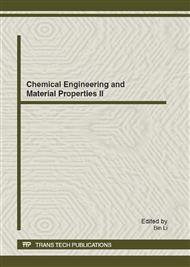[1]
J. P. Dong, X. L. Ji, and Y. W. Lei, Cost analysis of plastics filled by calcium carbonate, Chemical Industry, 2007, Vol 25, Issue 9, pp.32-34.
Google Scholar
[2]
L. Husarova, M. Machovsky, and P. Gerych, Aerobic biodegradation of calcium carbonate filled polyethylene film containing pro-oxidant additives, Polymer Degradation and Stability, Vol 95, Issue 9, September 2010, pp.1794-1799.
DOI: 10.1016/j.polymdegradstab.2010.05.009
Google Scholar
[3]
Q. Yuan, Y. Yang, and J. Chen, The effect of crystallization pressure on macromolecular structure, phase evolution, and fracture resistance of nano-calcium carbonate-reinforced high density polyethylene, Materials Science and Engineering, Vol 527, Issues 24-25, September 2010, pp.6699-6713.
DOI: 10.1016/j.msea.2010.07.007
Google Scholar
[4]
M. Tanniru and R. D. K. Misra, Reduced susceptibility to stress whitening during tensile deformation of calcium carbonate-reinforced high density polyethylene composites, Materials Science and Engineering: A, Vol 424, Issues 1-2, May 2006, pp.53-70.
DOI: 10.1016/j.msea.2006.02.034
Google Scholar
[5]
H. Ding, S. C. Lu, and Y. X. Deng, Mechano-activated surface modification of calcium carbonate in wet stirred mill and its properties, Transactions of Nonferrous Metals Society of China, Vol. 17, Issue 5, October 2007, pp.1100-1104.
DOI: 10.1016/s1003-6326(07)60232-5
Google Scholar
[6]
S. Sahebian, S. M. Zebarjad, and J. V. Khaki, The effect of nano-sized calcium carbonate on thermodynamic parameters of HDPE, Journal of Materials Processing Technology, Vol 209, Issue 3, February 2009, pp.1310-1317.
DOI: 10.1016/j.jmatprotec.2008.03.066
Google Scholar
[7]
Y. J. Liu, Progress on the application of calcium carbonate in plastics, Inorganic Chemicals Industry, 2008, Vol. 40, Issue 3, pp.11-13.
Google Scholar
[8]
W. Gao, X. Y. Ma, and Z. C. Wang, The influence of surface modification on the structure and properties of a calcium carbonate filled poly(ethylene terephthalate), Colloids and Surfaces A: Physicochemical and Engineering Aspects, Vol 389, Issues 1-3, September 2011, pp.230-236.
DOI: 10.1016/j.colsurfa.2011.08.022
Google Scholar
[9]
H. V. Tran, L. D. Tran, and H. D. Vu, Facile surface modification of nanoprecipitated calcium carbonate by adsorption of sodium stearate in aqueous solution, Colloids and Surfaces A: Physicochemical and Engineering Aspects, Vol 366, Issues 1-3, August 2010, pp.95-103.
DOI: 10.1016/j.colsurfa.2010.05.029
Google Scholar
[10]
Z. Y. Zhang, G. C. Qin, and Y. Chi, Study on refining ground calcium carbonate in plastic and vertical roller mill technology, China Non-Metallic Mining Industry Herald, 2010, Issue 5, pp.45-47.
Google Scholar
[11]
P. Rungruang, B. P. Grady, and P. Supaphol, Surface-modified calcium carbonate particles by admicellar polymerization to be used as filler for isotactic polypropylene, Colloids and Surfaces A: Physicochemical and Engineering Aspects, Vol 275, Issues 1-3, March 2006, pp.114-125.
DOI: 10.1016/j.colsurfa.2005.09.029
Google Scholar
[12]
C. Deshmane, Q. Yuan, and R.D.K. Misra, On the fracture characteristics of impact tested high density polyethylene–calcium carbonate nanocomposites, Materials Science and Engineering: A, Vol 452-453, April 2007, pp.592-601.
DOI: 10.1016/j.msea.2006.11.059
Google Scholar


